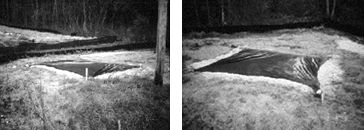U.S. Department of Transportation
Federal Highway Administration
1200 New Jersey Avenue, SE
Washington, DC 20590
202-366-4000
Focus
| Accelerating Infrastructure Innovations |
Publication Number: FHWA-RD-01-063
Date: April/May 2001
Triangular silt barriers, geotextile filter bags, and concrete blocks are just some of the products and ideas State highway agencies are using to better control soil erosion and sedimentation resulting from highway construction projects. The roadbuilding process often disturbs soil, which is then vulnerable to being washed downstream when it rains, causing a build-up of soil and other matter in waterways that is known as sedimentation. Excessive sedimentation can destroy fish habitat; clog streams, storm drains, and culverts; and pollute waterways, among other problems.
Since 1987, when an amendment to the Clean Water Act more broadly defined point source pollutants to include stormwater discharge from such industrial activities as construction, an increased number of environmental regulations have addressed the mitigation of highway runoff. In 1999, the U.S. Environmental Protection Agency (EPA) issued a final rule expanding its National Pollutant Discharge Elimination System stormwater program to include the regulation of construction sites that disturb one to five acres of land.
With the increased emphasis on erosion control resulting from the Clean Water Act and the 1991 Intermodal Surface Transportation Efficiency Act legislation, States are implementing a variety of new control methods. The Georgia Department of Transportation (DOT), for example, has started using geotextile filter bags to trap silt when pumping water from sediment basins and bridge footings. The bags are usually placed on a stone or gravel bed that has been sloped to ensure the filtered water will exit at the desired location. "We have used the filter bags on four bridge projects so far and they have worked out well," says David Graham of the Georgia DOT. For more information, contact Graham at 404-656-5306 (email: david.graham@dot.state.ga.us).
Delaware DOT is using what is known as a skimmer dewatering device to better trap soil in sediment basins. The device is a floating riser that attaches to the outlet by way of a flexible pipe. Compared to the perforated riser used previously, the floating riser better traps sediment at the surface of the basin. "It works really well," says Vince Davis of the Delaware DOT. "It is a walk-away device and relatively maintenance free." For more information, contact Salvador Palalay at Delaware DOT, 302-760-2188 (email: spalalay@mail.dot.state.de.us).

Georgia DOT is using the geotextile silt filter bags shown above to trap silt when pumping water from sediment basins and bridge footings.
The Illinois DOT has found success using articulated block mats, which are concrete blocks held together with cables. The blocks can be used for a number of erosion control applications, such as stabilizing slopes or as channel or ditch liners. Illinois has used them to control high velocity runoff in river bottom wetlands and as work pads at bridge construction sites. The block mats are laid on the river bed, so machines can run across them without kicking up too much silt. Richard Nowack of the Illinois DOT also reports success in using triangular silt barriers, which are employed to remove suspended particles from drainage water. The barrier consists of a permeable urethane foam core surrounded by a woven geotextile fabric and fixed to the ground with wire staples. For more information, contact Nowack at 217-785-2943 (email: nowackrj@nt.dot.state.il.us) or John L. Rowley at 217-785-2834 (email: rowleyjl@nt.dot.state.il.us).
Several States, including Georgia and North Carolina, are also experimenting with using the substance polyacrylamide (PAM) to accelerate the settlement of sediments. PAM, which comes in powder, emulsion, and gel-block form, binds small soil particles together so as to accelerate the settlement of suspended particles in sediment traps and ponds. For more information on PAM test projects in Georgia, contact James Magnus at the Georgia DOT, 404-656-5306 (email: james.magnus@dot.state.ga.us). For more information on North Carolina's PAM study, contact Byron Moore at North Carolina DOT, 919-733-2920 (email: bjmoore@dot.state.nc.us).
Through using the range of new erosion control methods outlined above, States are minimizing the impact of construction and maintenance operations and mitigating sediments and erosion concerns, resulting in not only better roads but a better environment.
| To assist State highway agencies in implementing erosion and sediment control measures and clarify FHWA and EPA requirements in this area, FHWA and EPA are jointly developing a National Highway Institute course, "Design and Implementation of Erosion and Sediment Control." Intended for designers, contractors, and inspectors, the course will address such topics as current regulatory requirements, erosion and sediment control principles, and management techniques for controlling erosion and sedimentation on highway construction and maintenance operations. The pilot for the course is tentatively scheduled to be held in late summer or early fall of this year. For more information, contact John Perry at FHWA, 202-366-2023 (fax: 202-366-9981; email: johna.perry@fhwa.dot.gov). |